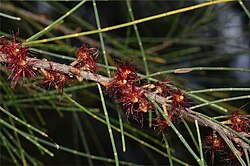Biology:Allocasuarina gymnanthera
| Allocasuarina gymnanthera | |
|---|---|

| |
| Branchlets and immature female cones | |
| Scientific classification | |
| Kingdom: | Plantae |
| Clade: | Tracheophytes |
| Clade: | Angiosperms |
| Clade: | Eudicots |
| Clade: | Rosids |
| Order: | Fagales |
| Family: | Casuarinaceae |
| Genus: | Allocasuarina |
| Species: | A. gymnanthera
|
| Binomial name | |
| Allocasuarina gymnanthera L.A.S.Johnson[1]
| |

| |
| Occurrence data from AVH | |

Allocasuarina gymnanthera is a species of flowering plant in the family Casuarinaceae and is endemic to eastern New South Wales. It is a dioecious shrub or tree that has more or less erect branchlets up to 200 mm (7.9 in) long, the leaves reduced to scales in whorls of six to eight, the fruiting cones 14–40 mm (0.55–1.57 in) long containing winged seeds (samaras) 4.5–7.0 mm (0.18–0.28 in) long.
Description
Allocasuarina gymnanthera is a dioecious shrub or tree that typically grows to a height of 2–5 m (6 ft 7 in–16 ft 5 in). Its branchlets are more or less erect, up to 200 mm (7.9 in) long, the leaves reduced to erect, scale-like teeth 0.4–0.7 mm (0.016–0.028 in) long, arranged in whorls of six to eight around the branchlets. The sections of branchlet between the leaf whorls (the "articles") are 5–12 mm (0.20–0.47 in) long and 0.5–1.0 mm (0.020–0.039 in) wide. Male flowers are arranged like a string of beads, in spikes 25–60 mm (0.98–2.36 in) long, with three to five whorls per centimetre (per 0.39 in.), the anthers 0.8–1.4 mm (0.031–0.055 in) long. Female cones are cylindrical, on a peduncle 3–8 mm (0.12–0.31 in) long, the mature cones 14–40 mm (0.55–1.57 in) long and 9–12 mm (0.35–0.47 in) in diameter, the samaras dark brown to black and 4.5–7.0 mm (0.18–0.28 in) long.[2][3][4]
Taxonomy
Allocasuarina gymnanthera was first described in 1989 by Lawrie Johnson in Flora of Australia.[4][5] The specific epithet, (gymnanthera) means "naked flowers".[4]
Distribution and habitat
This she-oak grows in open woodland on sandy soil on sandstone ridges between the Pilliga Scrub, Ulan, Baerami, Singleton and Glen Davis in eastern New South Wales.[2][3][4]
References
- ↑ "Allocasuarina gymnanthera". https://biodiversity.org.au/nsl/services/apc-format/display/82280. Retrieved 5 June 2023.
- ↑ 2.0 2.1 Wilson, Karen L.; Johnson, Lawrence A.S.. "Allocasuarina gymnanthera". Royal Botanic Garden Sydney. https://plantnet.rbgsyd.nsw.gov.au/cgi-bin/NSWfl.pl?page=nswfl&lvl=sp&name=Allocasuarina~gymnanthera.
- ↑ 3.0 3.1 "Allocasuarina gymnanthera". Australian Biological Resources Study, Department of Agriculture, Water and the Environment: Canberra. https://profiles.ala.org.au/opus/foa/profile/Allocasuarina%20gymnanthera.
- ↑ 4.0 4.1 4.2 4.3 Wilson, Karen L.; Johnson, Lawrence A.S. (1989). Flora of Australia. 3. Canberra: Australian Government Publishing Service. p. 196. https://www.dcceew.gov.au/sites/default/files/env/pages/a08d125d-a6d0-47c4-85e9-9b7ac5d4931a/files/flora-australia-03-hamamelidales-casuarinales.pdf. Retrieved 5 June 2023.
- ↑ "Allocasuarina gymnanthera". APNI. https://id.biodiversity.org.au/instance/apni/499328.
Wikidata ☰ Q15376074 entry
 |


